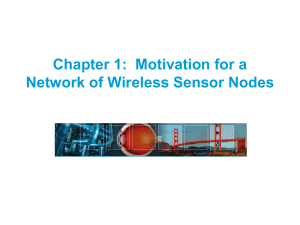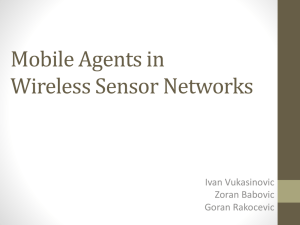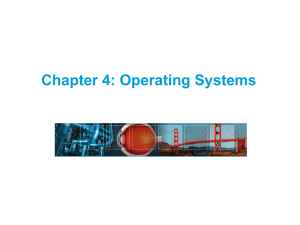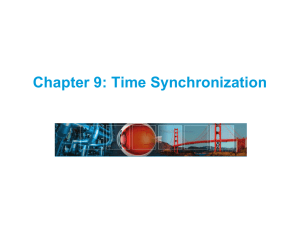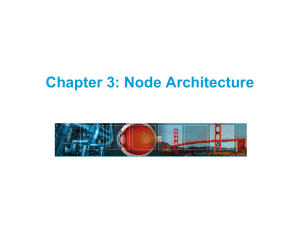PPT - extended version
advertisement
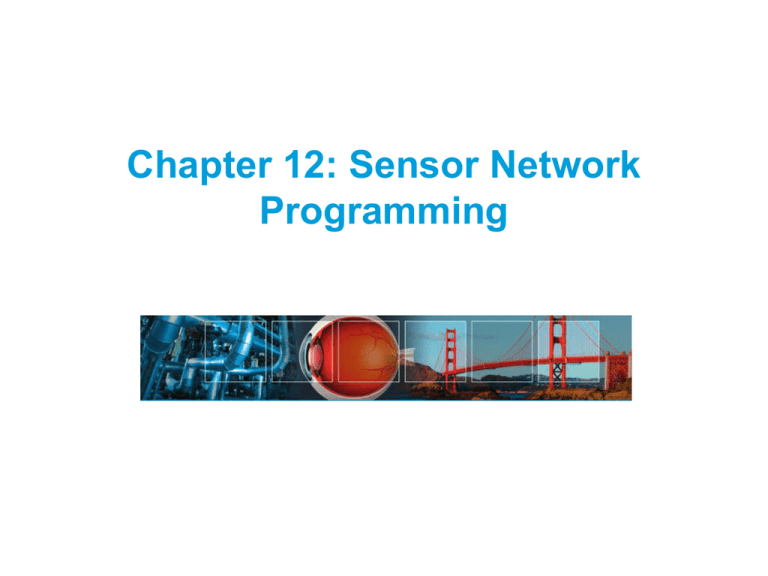
Chapter 12: Sensor Network
Programming
Chapter 12: Roadmap
Challenges
Node-centric programming
Macroprogramming
Dynamic reprogramming
Sensor network simulators
Fundamentals of Wireless Sensor Networks: Theory and Practice
Waltenegus Dargie and Christian Poellabauer © 2010
2
Challenges in WSN Programming
Reliability
resilience to changes and failures is important in WSNs
should be supposed by a programming environment
Resource constraints
resource limitations of WSNs affect maximum code size, performance,
memory/storage capacities
programming environment should allow programmer to exploit energysaving techniques
Scalability
sensor networks can be very large, i.e., programming models must
scale
manual configuration, maintenance, repair may be infeasible
Data-centric networks
focus is on the data, not the devices
Fundamentals of Wireless Sensor Networks: Theory and Practice
Waltenegus Dargie and Christian Poellabauer © 2010
3
Node-Centric Programming
Programming abstractions, languages, and tools focus on development of
SW on a per-node basis
Overall network-wide sensing task is then a collection of pairwise
interactions of sensor nodes
Fundamentals of Wireless Sensor Networks: Theory and Practice
Waltenegus Dargie and Christian Poellabauer © 2010
4
nesC Programming Language
TinyOS and nesC have become the de facto standard in WSN programming
nesC is an extension to C programming language
Provides set of language construct to implement SW for sensors
nesC applications consist of a collection of components and each
component has “provides” and “uses” interfaces
interface: describes the use of some kind of service
provides: set of method calls that are exposed to higher layers
uses: set of method calls that hide details of lower-layer components
Fundamentals of Wireless Sensor Networks: Theory and Practice
Waltenegus Dargie and Christian Poellabauer © 2010
5
nesC Programming Language
module TimerModule {
provides {
interface StdControl;
interface Timer;
}
uses interface Clock as Clk;
}
interface StdControl {
command result_t init ();
}
interface Timer {
command result_t start (char type, uint32_t interval);
command result_t stop ();
event result_t fired ();
}
Fundamentals of Wireless Sensor Networks: Theory and Practice
Waltenegus Dargie and Christian Poellabauer © 2010
6
nesC Programming Language
interface Clock {
command result_t setRate (char interval, char scale);
event result_t fire ();
}
interface Send {
command result_t send (TOS_Msg *msg, uint16_t length);
event result_t sendDone (TOS_Msg *msg, result_t success);
}
interface ADC {
command result_t getData ();
event result_t dataReady (uint16_t data);
}
Fundamentals of Wireless Sensor Networks: Theory and Practice
Waltenegus Dargie and Christian Poellabauer © 2010
7
nesC Programming Language
Example: timer interface:
two types of commands (functions): start, stop
commands are implemented by providers of an interface
event (function)
events are implemented by the users
Components have an implementation
modules are components implemented by application code
configurations are components implemented by connecting interfaces of
existing components
every nesC application has a top-level configuration
describes how components are “wired together”
functions are described as f.i (f is a function in an interface i)
functions are invoked using the call operation (for commands) and the
signal operation (for events)
Fundamentals of Wireless Sensor Networks: Theory and Practice
Waltenegus Dargie and Christian Poellabauer © 2010
8
nesC Programming Language
module PeriodicSampling {
provides interface StdControl;
uses interface ADC;
uses interface Timer;
uses interface Send;
}
Fundamentals of Wireless Sensor Networks: Theory and Practice
Waltenegus Dargie and Christian Poellabauer © 2010
9
nesC Programming Language
implementation P
uint16_t sensorReading;
command result_t StdControl.init () {
return call Timer.start (TIMER_REPEAT, 1000);
}
event result_ Timer.fired () {
call ADC.getData ();
return SUCCESS;
}
event result_t ADC.dataReady (uint16_t data) {
sensorReading = data;
…
return SUCCESS;
}
…
}
Fundamentals of Wireless Sensor Networks: Theory and Practice
Waltenegus Dargie and Christian Poellabauer © 2010
10
nesC Programming Language
StdControl.init is called at boot time
creates a timer that expires every 1000ms
upon time expiration, a new sensor sample is obained
ADC.getData triggers actual sensor data acquisition (ADC.dataReady)
Fundamentals of Wireless Sensor Networks: Theory and Practice
Waltenegus Dargie and Christian Poellabauer © 2010
11
nesC Programming Language
Example of wiring subcomponents: timer service in TinyOS (TimerC)
configuration TimerC {
provides {
interface StdControl;
interface Timer;
}
}
implementation {
components TimerModule, HWClock;
StdControl = TimerModule.StdControl;
Timer = TimerModule.Timer;
TimerModule.Clk -> HWClock.Clock;
}
Fundamentals of Wireless Sensor Networks: Theory and Practice
Waltenegus Dargie and Christian Poellabauer © 2010
12
nesC Programming Language
In TinyOS, code executes either asynchronously (in response to interrupt)
or synchronously (as a scheduled task)
Asynchronous code (AC): nesC code that is reachable from at least one
interrupt handler
Synchronous code (SC): nesC code that is reachable only from tasks
always atomic to other synchronous codes (tasks are always executed
sequentially and without preemption)
Race conditions occur when concurrent updates to shared state are
performed
shared state is modified from AC or
shared state is modified from SC that is also modified from AC
Fundamentals of Wireless Sensor Networks: Theory and Practice
Waltenegus Dargie and Christian Poellabauer © 2010
13
nesC Programming Language
nesC provides two options to ensure atomicity
convert all sharing code to tasks (SC only)
use atomic sections to modify shared state
…
event result_t Timer.fired () {
bool localBusy;
atomic {
localBusy = busy;
busy = TRUE;
}
…
}
…
Nonpreemption can be obtained by disabling interrupts during atomic
section (no call/signal allowed to ensure that atomic sections are brief)
Fundamentals of Wireless Sensor Networks: Theory and Practice
Waltenegus Dargie and Christian Poellabauer © 2010
14
TinyGALS
Globally Asynchronous and Locally Synchronous (GALS)
TinyGALS consists of modules composed of components
A component C has
set of internal variables VC
set of external variables XC
set of methods IC (that operate on these variables)
Methods are further divided:
calls in the ACCEPTSC set (can be called by other components)
calls in the USESC set (needed by C and may belong to other
components)
Fundamentals of Wireless Sensor Networks: Theory and Practice
Waltenegus Dargie and Christian Poellabauer © 2010
15
TinyGALS
TinyGALS defines components using an interface definition and
implementation (similar to nesC)
COMPONENT DownSample
ACCEPTS {
void init (void);
void fire (int in);
};
USES {
void fireOut (int out);
};
Fundamentals of Wireless Sensor Networks: Theory and Practice
Waltenegus Dargie and Christian Poellabauer © 2010
16
TinyGALS
Implementation for the DownSample component (_active is an internal
boolean variable that ensures that for every other fire() method, the
component will call fireOut() with the same integer argument)
void init () {
_active = true;
}
void fire (int in) {
if (_active) {
CALL_COMMAND (fireOut) (in);
_active = false;
} else {
_active = true;
}
}
Fundamentals of Wireless Sensor Networks: Theory and Practice
Waltenegus Dargie and Christian Poellabauer © 2010
17
TinyGALS
TinyGALS modules consist of components
Module M is a 6-tuple
M=(COMPONENTSM,INITM,INPORTSM,OUTPORTSM,PARAMETERSM,LINKSM)
COMPONENTSM … set of components of M
INITM … list of methods of M’s components
INPORTSM … inputs of the module
OUTPORTSM … outputs of the module
PARAMETERSM … set of variables external to the components
LINKSM … relationship between the method call interfaces and the inputs and
outputs of the module
Fundamentals of Wireless Sensor Networks: Theory and Practice
Waltenegus Dargie and Christian Poellabauer © 2010
18
TinyGALS
Modules are connected to each other to form complete TinyGALS system,
where a system is a 5-tuple
S=(MODULESS,GLOBALSS,VAR_MAPSS,CONNECTIONSS,STARTS)
MODULESS … set of modules
GLOBALSS … global variables
VAR_MAPSS … set of mappings (map global variable to a parameter of a
module)
CONNECTIONSS … list of connections between module output and input ports
STARTS … name of an input port of exactly one module (starting point for
execution)
Fundamentals of Wireless Sensor Networks: Theory and Practice
Waltenegus Dargie and Christian Poellabauer © 2010
19
TinyGALS
Highly structured architecture of TinyGALS can be exploited to automate the
generation of scheduling and event handling code
frees developers from writing error-prone concurrency control code
Code generation tools can automatically produce:
all necessary code for component links and module connections
code system initialization
code for start of execution
code for intermodule communication
code for global variables reads and writes
Modules use message passing and are therefore decoupled from each other (easier
independent development)
each message triggers scheduler and activate receiving module
TinyGUYS (Guarded Yet Synchronous) variables:
modules read global variables without delay (synchronously)
modules write global variables using buffer (asynchronously)
–
buffer size is 1 (i.e., last writing module wins)
Fundamentals of Wireless Sensor Networks: Theory and Practice
Waltenegus Dargie and Christian Poellabauer © 2010
20
Sensor Network Application Construction Kit
SNACK consists of a configuration language, component and service
library, and compiler
Goals are:
to provide smart libraries that can be combined to form WSN
applications
to simplify the development process
to be efficient
It should be possible to write simple pieces of code such as:
SenseTemp -> [collect] RoutingTree;
SenseLight -> [collect] RoutingTree;
Fundamentals of Wireless Sensor Networks: Theory and Practice
Waltenegus Dargie and Christian Poellabauer © 2010
21
Sensor Network Application Construction Kit
Syntax of SNACK code:
service Service {
src :: MsgSrc;
src [send:MsgRcv] -> filter :: MsgFilter -> [send] Network;
in [send:MsgRcv] -> filter;
}
n::T declares an instance named n of a component type T (i.e., an instance
is an object of a given type)
n[i:τ] indicates an output interface on component n with name i and interface
type τ (similarly, [i:τ]n is an input interface)
A component provides its input interfaces and uses its output interfaces
Fundamentals of Wireless Sensor Networks: Theory and Practice
Waltenegus Dargie and Christian Poellabauer © 2010
22
Sensor Network Application Construction Kit
SNACK library
variety of components for sensing, aggregation, transmission, routing, and data
processing
several core components supported
Network: receives/sends messages from/to TinyOS radio stack
MsgSink: ends inbound call chains and destroys received buffers
MsgSrc: generates periodic empty SNACK messages and passes them to
outbound interface
Timing:
–
TimeSrc: generates a timestamp signal sent over signal interface at
specified minimum rate
–
TimeSink: consumes such signals
Storage: implemented by components such as Node-Store64M, which
implements an associative array of eight-byte values keyed by node ID
Service: variety of services (e.g., RoutingTree implements a tree designed to
send data up to some root)
Fundamentals of Wireless Sensor Networks: Theory and Practice
Waltenegus Dargie and Christian Poellabauer © 2010
23
Thread-Based Model
Multiple tasks allowed to make progress in execution without concern that a
task may block other tasks (or be blocked) indefinitely
Task scheduler manages task execution
example: time-slicing approach, where tasks execute for certain amount
of time
MANTIS (MultimodAl system for NeTworks of In-situ wireless Sensors)
thread-based operating system for WSNs
memory-efficient
requires less than 500 bytes of RAM
14 kbytes of flash memory
energy-efficiency
microcontroller switches to low-power sleep state after all active
threads have called the sleep() function
Fundamentals of Wireless Sensor Networks: Theory and Practice
Waltenegus Dargie and Christian Poellabauer © 2010
24
Thread-Based Model
TinyThread
adds support for multithreaded programming to TinyOS and nesC
procedural programming of sensors
includes suite of interfaces that provide blocking I/O operations and
synchronization primitives
Protothreads
lightweight stackless type of threads; all protothreads share the same stack
context switch is done by stack rewinding
variables must be saved before calling a blocking wait (variables with functionlocal scope that are automatically allocated on stack are not saved across wait
calls)
Y-Threads
preemptive multithreading (distinguish preemptable from nonpreemptable code)
shared stack for nonblocking parts, thread-specific stack for blocking calls
blocking portions of code require only small amounts of stack, leading to
better memory utilization compared to other preemptive approaches
Fundamentals of Wireless Sensor Networks: Theory and Practice
Waltenegus Dargie and Christian Poellabauer © 2010
25
Macroprogramming
Focus on programming group of nodes, instead of individual nodes
Abstract Regions
focuses on group-level cooperation
group of nodes working together to sample, process, and
communicate sensor data
region-based collective communication interface
defines neighborhood relationship between nodes
“the set of nodes within distance d”
type of definition of abstract region depends on the type of application
examples of implementations of abstract regions
N-radio hop (nodes within N radio hops)
k-nearest neighbor (k nearest nodes within N radio hops)
spanning tree (rooted at a single node, used for data aggregation
over entire network)
Fundamentals of Wireless Sensor Networks: Theory and Practice
Waltenegus Dargie and Christian Poellabauer © 2010
26
Macroprogramming
Abstract Region (contd.)
example:
regions defined using hop distances
discovery of region members using periodic broadcasts
(advertisements)
data can be shared between region members using a “push”
(broadcasting) or “pull” (issue a fetch message) approach
Fundamentals of Wireless Sensor Networks: Theory and Practice
Waltenegus Dargie and Christian Poellabauer © 2010
27
Macroprogramming
EnviroTrack
object-based middleware library
geared toward target-tracking sensor applications
free developer from details of
interobject communication
object mobility
maintenance of tracking objects and their state
also uses the concept of groups, which are formed by sensors which
detect certain user-defined entities in the physical environment
groups are identified by context labels (logical addresses that follow the
external tracked entity around in the physical environment)
Fundamentals of Wireless Sensor Networks: Theory and Practice
Waltenegus Dargie and Christian Poellabauer © 2010
28
Macroprogramming
EnviroTrack (contd.)
tracking objects: objects can be attached to context labels to perform
context-specific operations; executed on the sensor group of the context
label
type of context label depends on entity (e.g., context label car is created
wherever a car is tracked)
context label of some type e:
function sensee(): describes sensory signature identifying tracked
environmental target (car: magnetometer and motion sensor
readings)
also used to track group membership
aggregation function statee(): environmental state shared by all
objects attached to a context label
acts on the readings of all sensors for which sensee() is true
aggregation is performed by sensor node acting as group leader
Fundamentals of Wireless Sensor Networks: Theory and Practice
Waltenegus Dargie and Christian Poellabauer © 2010
29
Macroprogramming
Database approaches treat entire WSN as a distributed database that can
be queried
TinyDB
network is represented logically as a table (called sensors)
one row per node per instant in time
each column corresponds to sensor readings (light, temperature,
pressure, …)
new record is added when a sensor is queried
new information is usually stored for a short period of time only
queries are like SQL-based queries (SELECT, FROM, WHERE, etc.)
SELECT nodeid, light, temp
FROM sensors
SAMPLE PERIOD 1s FOR 10s
initiates data collection at beginning of each epoch (specified in SAMPLE
PERIOD clause); results are streamed to the root of the network
Fundamentals of Wireless Sensor Networks: Theory and Practice
Waltenegus Dargie and Christian Poellabauer © 2010
30
Macroprogramming
TinyDB (contd.)
supports group aggregation queries
example: monitoring microphone-equipped rooms; look for rooms where
the average volume is over a certain threshold:
SELECT AVG(volume), room FROM sensors
WHERE floor = 6
GROUP BY room
HAVING AVG(volume) > threshold
SAMPLE PERIOD 30s
Similar projects
Cougar: resource-efficient database appraoch
SINA: models WSN as collection of distributed objects; supports SQTL
scripts in SQL queries
MiLAN: sensor applications can specify QoS needs
Fundamentals of Wireless Sensor Networks: Theory and Practice
Waltenegus Dargie and Christian Poellabauer © 2010
31
Dynamic Reprogramming
Sometimes necessary to disseminate code to all or some sensor nodes
Virtual machines
Maté
small VM on top of TinyOS
capsules (sequence of 24 instructions) inside a single TinyOS
packet
every capsule includes type and version information
–
message send capsules
–
message receive capsules
–
timer capsules
–
subroutine capsules
programs execute in response to events (e.g., timer firing, packet
being sent/received)
each event has a capsule and an execution context
Fundamentals of Wireless Sensor Networks: Theory and Practice
Waltenegus Dargie and Christian Poellabauer © 2010
32
Dynamic Reprogramming
Virtual machines (contd.)
Maté (contd.)
jumps to first instruction of capsule and executes until halt instruction
when subroutine called, return address is pushed onto a return address
stack; upon return, address is taken from the stack
Trickle
controlled flooding protocol for disseminating small pieces of code
uses metadata to describe code (allows node to determine if code update
needed)
metadata is exchanged among neighbors via broadcast
periodic time intervals, each node randomly selects broadcast time during
each interval
when a node hears outdated metadata, it broadcasts its own code, giving
outdated node chance to update
when a node overhears newer metadata, it broadcasts its own metadata,
triggering the neighbor to broadcast newer code
Fundamentals of Wireless Sensor Networks: Theory and Practice
Waltenegus Dargie and Christian Poellabauer © 2010
33
Dynamic Reprogramming
Melete
similar to Maté and Trickle
supports multiple concurrent applications
supports selective dissemination by limiting dissemination range
code is only forwarded within a forwarding region
Deluge
occasionally advertises the most recent code version using broadcasts
if a node receives an update with old code, it responds with new code version
(allowing neighbor to request new code)
eliminates redundant advertisements and request messages
provides robustness
uses a three-phase handshake to ensure that only symmetric links are used
allowing a node to search for a new neighbor to request code if it has not
completely received the code after k requests
dynamically adjusts rate of advertisements for quick propagation when needed,
but consuming few resources in steady state
Fundamentals of Wireless Sensor Networks: Theory and Practice
Waltenegus Dargie and Christian Poellabauer © 2010
34
Dynamic Reprogramming
Pump Slowly, Fetch Quickly (PSFQ)
slowly pace propagation of packets (pump slowly)
aggressively fetch lost packets (fetch quickly)
nodes do not relay packets out of order
prevents loss events from propagating downstream
localized recovery allows nodes to recover lost packets from immediate
neighbors (reduces recovery costs)
Push Aggressively with Lazy Error Recovery (PALER)
based on observation that pushing data downstream and recovering lost packets
simultaneously leads to excessive contention
eliminates in-order reception requirement
pushes all data aggressively
nodes keep list of missing packets and request retransmission after the
broadcast period
retransmission requests are handled by neighbors (if they don’t have a copy of
missing data, they issue their own request to their neighbors)
Fundamentals of Wireless Sensor Networks: Theory and Practice
Waltenegus Dargie and Christian Poellabauer © 2010
35
Sensor Network Simulators
Large scale of sensor networks makes implementation and experimentation
difficult and expensive
Instead, simulation is used to evaluate novel WSN tools, mechanisms,
protocols, and applications
Quality of simulations depends on choice of appropriate models for
sensor node hardware/software characteristics
wireless communication
physical environment
node mobility
Simulators typically come with tools for collecting, analyzing, and visualizing
sensor data
Fundamentals of Wireless Sensor Networks: Theory and Practice
Waltenegus Dargie and Christian Poellabauer © 2010
36
ns-2
Discrete event simulator called network simulator (ns-2)
Written in C++ and Otcl
Highly extensible, many extensions have been developed, e.g.:
extension adding the concept of a phenomenon (physical event)
uses broadcast packets over designated channel to represent
physical phenomena (fire, moving vehicle, chemical cloud)
uses PHENOM routing protocol: emits packets with certain
configurable pulse rate and whose arrival triggers a receive event
many routing protocols
many MAC-layer protocols
variations of packet contents
models for multi-homed devices
mobility models
Fundamentals of Wireless Sensor Networks: Theory and Practice
Waltenegus Dargie and Christian Poellabauer © 2010
37
GloMoSim and QualNet
GloMoSim
based on the PARSEC (PARallel Simulation Environment for Complex
systems) simulation environment
C-based simulation language
represents sets of objects in physical environment as logical
processes
represents interactions among these objects as time-stamped
message exchanges
supports variety of models at different protocol layers
supports different mobility models
intended for academic use
QualNet
commercial version of GloMoSim
produced by Scalable Network Technologies, Inc.
Fundamentals of Wireless Sensor Networks: Theory and Practice
Waltenegus Dargie and Christian Poellabauer © 2010
38
JiST/SWANS
Java in Simulation Time (JiST)
discrete event simulator
efficient
run program in parallel
dynamically optimize simulator configuration
transparent
transform simulation programs automatically to run with simulation
time semantics (instrument simulations such that no programmer
intervention or calls to specialized libraries are needed to support
concurrency, consistency, reconfiguration, etc.)
Scalable Wireless Ad hoc Network Simulator (SWANS)
built on top of JiST
collection of independent SW components that can be aggregated to
form complete wireless (ad hoc) simulations
Fundamentals of Wireless Sensor Networks: Theory and Practice
Waltenegus Dargie and Christian Poellabauer © 2010
39
OMNeT++
Objective Modular Network Testbed
discrete event simulator for simulating communication networks,
multiprocessors, and distributed systems
open-source based on C++
models consist of modules that communicate using message passing
simple modules and compound modules
uses topology description language NED to define structure of a module
includes graphical editor
lacks protocol models
Fundamentals of Wireless Sensor Networks: Theory and Practice
Waltenegus Dargie and Christian Poellabauer © 2010
40
TOSSIM
Simulator for TinyOS-based networks
Generates discrete event simulations directly from TinyOS components
(i.e., runs the same code that runs on the sensors)
Replaces low-level components (e.g., interrupts) with events in the
simulations
Simulator event queue delivers these events to components
Works at bit level, i.e., event is generated for each sent or transmitted bit
allows for experimentation with low-level protocols
TinyViz: visualization tool
Very scalable and extensible
Lacks energy profiling and use is limited to TinyOS systems
Fundamentals of Wireless Sensor Networks: Theory and Practice
Waltenegus Dargie and Christian Poellabauer © 2010
41
EmStar
Targeted at high capability nodes called microservers (e.g., cluster heads)
Consists of a Linux microkernel extension, libraries, and several tools
EmSim: operates many virtual nodes in parallel in a simulation that models
radio and sensor channels
EmCee: runs the EmSim core and is an interface to real low-power radios
EmView: graphic visualizer
Fundamentals of Wireless Sensor Networks: Theory and Practice
Waltenegus Dargie and Christian Poellabauer © 2010
42
Avrora
Flexible simulator framework in Java
Each node is its own thread and code is executed instruction-by-instruction
Event queue:
targets nodes operating in long sleep modes
event queue takes advantage of that to boost performance
when node sleeps, only a time-triggered event that causes an interrupt
can wake up the node
such an event is inserted into event queue of the node to be woken up
at a certain time
simulator processes events in order until one of them triggers a
hardware interrupt, which re-awakes a node
Fast and scalable simulator; can simulate down to the level of individual
clock cycles
Fundamentals of Wireless Sensor Networks: Theory and Practice
Waltenegus Dargie and Christian Poellabauer © 2010
43

